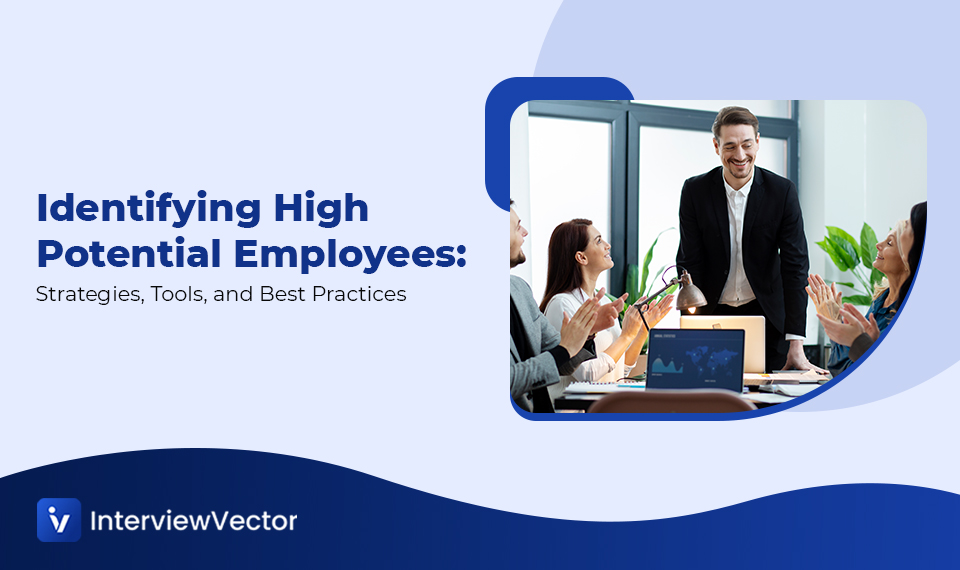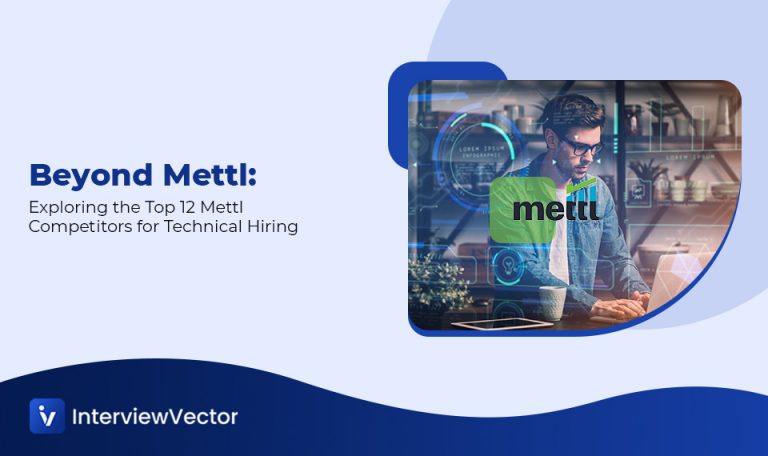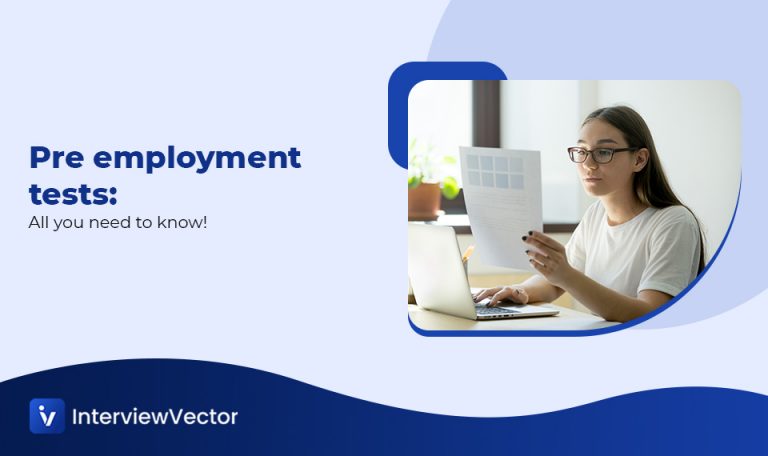Introduction
It is a relay race in which organizations continue searching for talent who can generate innovations and maintain growth rates. High-potential employees are unique individuals who are top performers with the potential for additional development for leadership and strategic roles in the future. Identifying and nurturing these individuals can result in significant benefits for organizations, such as better development of leadership potential, improved team performance, and, ultimately, organizational resilience.
This blog discusses why it is important to identify HiPos, their characteristics, approaches to identifying HiPos, challenges, how to manage their advantages for HiPos development, and how organizations can benefit from using InterviewVector to identify HiPos.
What is high potential?
In the context of employees in an organisation, a high potential employee or a HiPo employee is one who display the ability, commitment and drive to excel in their current roles and go above and beyond it to take up more responsibility. Usually, most companies have a high potential process that enables them to identify such employees specifically.
Usually, the high potential identification process helps companies list employees who can be considered for senior positions in future. Companies usually evaluate employees on a list of parameters to identify talents and potentials that they are looking for. This helps them segregate high potential employees and train them separately so they are more prepared for leadership positions within the system.
Importance of developing and identifying HiPo employees
Driving Organizational Growth
High-potential employees introduce new thinking, better approaches, and dedication to pursuing excellence. They are mostly central to causing change in organizations especially in growing competitive industries.
Leadership Pipeline Development
The identification of HiPos ensures organizations’ adequate preparation for leadership advancement. Sustaining operational leadership and direction requires developing a leadership pipeline.
HiPos are innate leaders ready to adapt and motivate others; they fully fit the pipeline. To mitigate the risks of leadership gaps, companies can prepare them early for leadership roles through talented development programs.
Increased Employee Retention
Loyalty amongst employees is statistically demonstrated when workers feel appreciated for their potential and when the company offers chances to grow. HiPo identification also offers a good method of increasing retention, as the approach establishes that the organization cares about its employees and their advancement.
Enhanced Team Dynamics
HiPos creates positivity and productivity’s domino effect. They can usually set a pace that others follow, which helps generate cooperation and efficient output.
Strategic Workforce Planning
The process of identifying HiPos links talent management with an organization’s goals. Such an approach ensures the company’s readiness for future tasks and problems, be they scale expansion, introducing innovative technologies, or shocking changes.
What are the characteristics of high-potential employees
High-potential employees stand out due to some of the key features that make them uniquely capable of excelling in a demanding marketplace and adapting to future challenges:
Learning Agility
HiPos thrive on learning; they take little time to learn new things and can adapt to changes in their position or a particular field in general. This trait is valuable when operating in environments where many changes happen regularly, such as technology or data-driven companies, especially when it comes to hiring and skills assessment with the help of solutions like InterviewVector.
Leadership Potential
HiPos, natural leaders, persuade people. They are strategic-thinking individuals who can make firm decisions that will influence the result achieved once a choice is made.
Emotional Intelligence (EI)
HiPos excels in relationship management and perceives interpersonal and inter-group dynamics. They can also listen, express themselves, and show calmness under enormous pressure.
Consistent High Performance
This trend has resulted in its proving itself among the best contractors without needing an introduction. HiPos can be relied upon to perform outstandingly, go the extra mile to ensure things get done, and sometimes volunteer for added responsibilities.
Resilience and Adaptability
HiPos sees challenges as development prospects. They don’t get easily discouraged, thereby enabling them to avoid being distracted when encountering one hurdle or the other.
Differentiating Performance from Potential
One of the most common challenges in identifying high-potential employees (HiPos) is distinguishing between performance and potential. While high performers excel in their current roles, they may not necessarily possess the capabilities required for future leadership or strategic positions. It is important to note that difference to avoid falling into the trap of offering a promotion to employees based on their current performance.
Performance vs. Potential: Key Differences
| Aspects | Performance | Potential |
| Focus | Mastery of current responsibilities and achieving short-term goals. | Ability to grow into larger roles and contribute to long-term objectives. |
| Scope | Consistently delivers high results within their job scope. | Demonstrates adaptability, vision, and readiness to tackle new challenges. |
| Skillset | Excels at specific technical or functional skills. | Exhibits leadership qualities, emotional intelligence, and strategic thinking. |
| Learning Agility | May focus on refining current skills. | Shows a hunger for learning and quickly adapts to new situations. |
How do you Identify High-Potential Employees?
To identify HiPos, a combination of strategic human resource management tools, conventional assessment methods, and modern technology must be used.
- Psychometric Assessments
Psychometric tools offer employers factual information about an employee or candidate’s strengths and weaknesses. Such attitudes show information beyond the controllable, observable features, enabling the identification of an employee’s fit for growth roles.
- Competency-Based Interviews
Interviews conducted on a structured basis that include questions related to competencies enable the discovery of an employee’s problem-solving skills, leadership qualities, or ability to deal with change.
Companies can specify the competencies they need with interview questions, they can employ templates that align to match their preferences that are available on various competency assessments tools.
- AI-Driven Talent Assessment
Various online platforms process performance information and statistics, behavioral patterns, and skills employing AI. These are valuable as they assist organizations in reducing the time needed to identify their HiPos while considering no bias in the process.
- Behavioral Observations
HiPos are sometimes characterized by initiative, problem-solving skills, and work commitment. Managers can identify these attitudes during group meetings, projects, or tasks.
- Alignment with Organizational Goals
Consequently, it is paramount that the HiPo identification be made in relation to the long-term business strategies. This helps ensure that the chosen employees meet the qualifications of high performers and adhere to the organizational strategic plan.
Challenges in identifying high potential employees
- Bias in Evaluation
Top management biases emanate from the employees’ side, as they tend to choose potentials for development based on bias instead of merit.
- Lack of Clear Criteria
When HiPo is not defined clearly, the organization may identify the wrong talents, deny itself good talents for development, or devise the wrong capabilities development programs.
- Resistance to Change
Some employees might resist being categorized as HiPos due to concerns about increased expectations and responsibilities.
- Confidentiality vs. Transparency
One of the biggest challenges in managing the HiPo identification process is knowing when to keep it confidential and when little transparency is required.
- Limited Resources
Several small and medium organizations might need more resources to effectively support and develop efficient HiPo identification systems.
Solutions
Organizations can manage engagement challenges in several ways, including using data-based tools, ensuring transparency, and providing constant formal and informal training and feedback.
Best practices for developing high-potential employees
The first step is to recognize HiPos individuals. Developing skills and capabilities is an area of equal significance. So to check what can be the best practices which can be adhered to are mentioned below:
- Personalized Development Plans: Develop specific personal/professional development programs based on each person’s strengths, weaknesses, and career objectives.
- Provide Stretch Assignments: Assign difficult tasks that push the HiPos to move out of their comfort levels and gain better experiences with new skills.
- Foster Mentorship Programs: Combine HiPos with talented employees to make the best matches with the mentors who will be the best fit for the HiPos for their professional development.
- Encourage Continuous Learning: Invest in training programs, workshops, and online courses to enhance HiPos’ knowledge and skills.
- Offer Regular Feedback: Provide corrective feedback to assist the HiPos in making necessary adjustments to achieve the organization’s goal.
- Recognize and Reward Contributions: Recognizing HiPos helps them feel appreciated and valued and motivates them to work hard to ensure the growth of their organization.
Measuring the Success of High Potential Employees Program
To ensure the effectiveness of HiPo programs, organizations must track and measure their impact:
1. Retention Rates: It is also necessary to analyze the HiPos retainment rates in order to measure the effectiveness of development activities.
2. Leadership Progression: This would be important in ascertaining how the HiPos promoted to other levels can benefit the organization’s succession plan.
3. Performance Metrics: Evaluate the HiPos in their capacities and establish their productivity concerning organizational objectives.
4. Employee Feedback: Seek HiPos’ views to better understand the need to enhance the development programs.
5. ROI Analysis: Assess the impact or ROI of HiPo programs by focusing on the effectiveness of development initiatives and the gains made.
Tools to measure high potential employees:
With more and more companies increasing their focus on high potential identification process, the demand for automated tools to help with it has increased. Most companies use dynamic and modern high potential identification methods when they want to hire HiPo individuals in the system.
To help companies identify talents and potentials, there are multiple HiPo identification tools that can be implemented. While some of these tools are usually used by companies only when they are hiring for a senior position, these tools can help you identify talents and potentials across all levels of the organisation. High potential identification tools also help in streamlining the hiring process, thus making it more cost-effective and bias-free.
Some tools that are used in the process of high potential identification process are as follows:
Assessment Battery: It provides with a suite or battery of tests that help employers identify high talents and potentials in their employees. This tool offers a range of personality and ability tests that can be administered to employees. The marks scored by employees are further analysed to understand their future potential.
360-degree feedback: This tool is usually used by companies to help in appraisals and promotions. This tool facilitates a process whereby an employees’ parallel colleagues/peers, seniors, direct reportees and sometimes even customers give feedback about him or her. This helps in ascertaining an employee’s contribution from different perspectives. Hence, this tool enables employers do a holistic evaluation of their employees and hence the name “360-degree feedback”. While this tool is used mainly for promotions and appraisals, it can also be customised and used to hire new employees.
Assessment and development center: Also known as ACDC, this tool give a combination of different types of tests such as roleplays, group discussions, psychometric and aptitude tests and situational judgement tests. These tests along with interviews helps employers do holistic evaluation of their employees. It also helps employers hire new employees for different roles within the organisation. It helps employers make critical decisions like matching the right candidate for the right role and for employees’ growth and development.
ACDC can be taken in the following ways:
- Virtual ACDC: These are most suitable for mid-level employees and individual contributors. These help in savings unnecessary costs of test center as all candidates can take tests virtually. The best part is virtual ACDCs generate detailed reports of candidates immediately after the test which helps in speedy analysis.
- Traditional ACDC: It takes place in an offline setting in the presence of a team of assessors. It is usually not a popular choice as it leads to multiple expenses when compared to virtual ACDCs.
- Blended ACDC: It’s a combination of on-filed programs along with virtual tests. This method also helps in getting detailed reports of candidates and is a suitable blended high potential identification process that is favoured by many.
How interviewVector can help
Using artificial intelligence technology, InterviewVector conducts assessments, interviews, and performance analysis tools for such behavioral traits. Utilizing patterns of data-based performance, InterviewVector contributes to efficient HiPos selection by including potential and performance throughout the evaluation process.
Organizations can confidently select and develop future leaders when complementing the consideration of behavioral markers and the distinction between performance and potential.
Conclusion
Recognizing potential employees is one of the strategic cores of organizational development to achieve sustainable competitive advantages. Using proper approaches, techniques, and processes, any company’s workforce can be optimally developed, and a leadership talent pipeline can be established. Platforms like InterviewVector make it easy for organizations to locate and evaluate HiPos and nurture them perfectly.
To put it bluntly, the investment behind HiPo identification and development is not just a recognition of talent but the creation of your organization. To succeed with the HiPo strategy, HiPo development must be an urgent priority in today’s competitive business environment.
With the appropriate mechanism and the commitment to growth, businesses can empower their workforce, nurture talent, and maintain organizational competitiveness in today’s dynamic environment. Let InterviewVector be your partner in this innovational process and help your organization succeed with the help of top experts.














